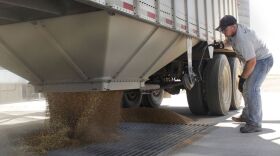From Kansas Agland:
Many people assume nothing is going on with the alfalfa weevil during the winter months, or maybe that any eggs present will die during cold weather. That is not the case. Alfalfa weevils are cool-weather insects. Adults lay eggs in alfalfa fields in the fall or even the winter. Most of these eggs survive the winter, and continue to develop at temperatures above 48ºF.
Eggs hatch and larvae emerge in the spring after accumulating enough degree days or thermal units. Alfalfa weevil adults also lay eggs in the spring, but in many cases the first larvae to emerge are from eggs that were laid in the fall and overwintered.
Early scouting for alfalfa weevil
Scouting for alfalfa weevil larvae should start after plants break dormancy. A degree day or thermal unit accumulation system can be used to predict when to initiate scouting. Insect development is controlled by temperature. This can be used to help manage these pests. Weevil activity has been tracked in Kansas for the past few years and has been used to generate recommendations (see table below).
Approximate degree days required for alfalfa weevil development

Because it is impossible to determine whether eggs were laid in the fall, winter, or spring, the degree day model may vary considerably, but it is useful for indicating when to start a scouting program. The base temperature for alfalfa weevils, or the temperature below which there is no development, is approximately 48ºF. Every day after oviposition that the temperature exceeds 48ºF, the eggs mature and get closer to hatching. Hatching usually occurs after about 300 degree days. In Kansas, scouting for the presence of eggs and the first signs of larvae should start after the accumulation of about 180 degree days from January 1.
To calculate a degree day, record the daily high temperature anytime it exceeds 48ºF. For example, if there is only one day in January that the temperature exceeded 48ºF, take that temperature and add the lowest temperature for that day, or 48ºF, whichever is higher. Then divide by 2 to calculate the average temperature for that day. Next, subtract 48ºF.
As an example, say there was one day in January when the high temperature was 60ºF and the low was 35ºF. You would use 48ºF as the default value for the low instead of 35ºF. The calculation in this case would be:
[(60 + 48)/2] – 48 = 54 – 48 = 6 degree days (or weevil development units)
Continue recording and summing degree days until you have accumulated 150 to 180. That is when to start scouting alfalfa fields because the first eggs will start hatching soon. The location where the daily temperature is recorded is probably not exactly the same as where weevils are developing, so the model may be off a little, but it can save time by alerting you to when eggs should start hatching.
Do not be too quick to treat for alfalfa weevil. Wait until the field reaches the treatment threshold. Treating too early is not only unnecessary, it can also have detrimental effects by killing beneficial insects.
For more details, see Alfalfa Weevils, K-State publication MF-2999, at your local county Extension office, or http://www.bookstore.ksre.ksu.edu/pubs/MF2999.pdf
Other early spring alfalfa insects
The next insect to start watching for would probably be pea aphids. They can also start relatively early in the spring, and can be a problem on first-year stands. If weevil treatments are applied, they will wipe out any beneficial insects -- which normally do a good job of keeping aphid populations under control.
Also, producers need to keep an eye out for army cutworms as there were some reports of army cutworm activity last fall. Army cutworms start feeding again anytime temperatures are above 50 degrees F. Armyworms are another potential problem.
Those are the early season pests which have the most potential for damaging alfalfa prior to the first cutting. For more information on control, see K-State publication MF-809, Alfalfa Insect Management 2015, at: http://www.bookstore.ksre.ksu.edu/pubs/MF809.pdf







